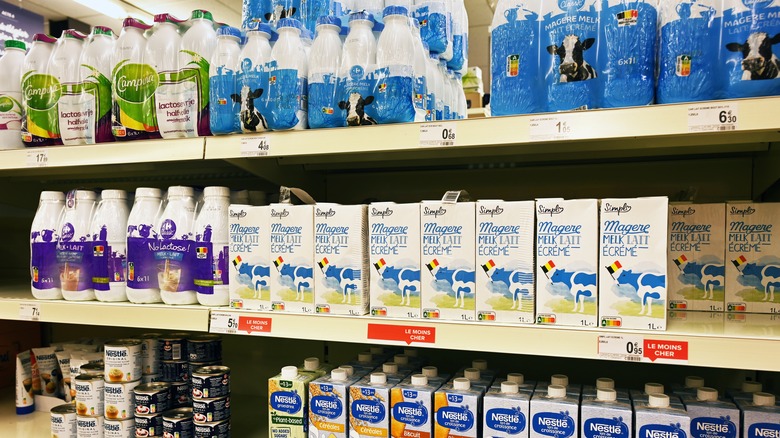The Strange Place Tourists Visiting A Grocery Store In Europe Will Find Milk
There are two types of travelers: those who view grocery stores as an essential tourist attraction and those who don't. Supermarkets reveal much about your travel destination's cultural norms, dietary habits, and regional specialties — they're also the best place to buy travel souvenirs. As you enter a European grocery store, you might be in for a surprising discovery: Milk is not where it's supposed to be. Unlike the U.S. or Canada, where milk is found in the refrigerated section, in many European countries, milk is often located in an entirely unexpected place — on regular shelves, unrefrigerated.
The first time a tourist stumbles upon milk sitting on a grocery store shelf — whether they're deliberately looking for some to stock up at their European Airbnb or simply sightseeing — it can be puzzling. Milk is a perishable product, so it's natural to assume it requires refrigeration. Here's the thing: Milk found on European shelves is not the same as the fresh, ice-cold milk found in North American supermarkets. In Europe, it's common to find a type of milk called UHT, or Ultra-High Temperature milk.
UHT milk undergoes a process where milk gets heated to 280 degrees Fahrenheit for about two seconds, which kills more bacteria than the traditional pasteurization process. As a result, UHT milk has a long shelf life (six to nine months, unopened!) and doesn't require refrigeration until opened. In contrast, North America uses a High-Temperature Short-Time (HTST) pasteurization process, where the milk gets heated to over 161 degrees for 15 to 20 seconds before being cooled and put in the fridge. The result is milk that only lasts for a few weeks, so long as it's kept cold.
UHT milk: a European standard
UHT milk is most popular in southern and western European countries, such as Spain, Portugal, Italy, France, Belgium, and Germany. It's least popular in the UK, Denmark, and Nordic countries like Finland, Sweden, and Norway. In fact, America and Canada are outliers with their cold HTST milk; the rest of the world, from Asia to Africa to South America to Europe — for the most part — drinks UHT. You'll even find UHT milk at Japan's one-of-a-kind milk stands.
Europeans love their UHT milk for several reasons. First, it can be stored for months without spoiling, resulting in fewer "We ran out of milk!" emergencies. UHT milk is also more convenient for small European households, where refrigerators are often smaller, and grocery shopping is done more frequently (America is quite idiosyncratic with its bombastic two- and sometimes three-door fridges). The ability to store milk in the pantry rather than taking up valuable fridge space is a significant advantage. Finally, UHT milk is more environmentally friendly, and Europeans are known to be world leaders in sustainability and green practices. It requires less energy for storage and transportation, plus it reduces food waste due to its extended shelf life.
In 1993, Parmalat, the world's leading UHT milk processing company, attempted to introduce UHT milk to the American market. It failed miserably. Whether it's the love of fridges, love of a cold glass of milk, or love for milk with cookies/cereal/etc. — fresh, cold, HTST milk is the North American standard. Different milks for different folks, right?
Taste and cultural differences
You might be wondering: Does UHT milk taste different? The answer is yes, but the difference is subtle. The UHT pasteurization process alters the flavor of the milk, giving it a slightly caramelized taste. It is also less sweet compared to American HTST milk, as most of the sugar gets burned off (caramelized) in the pasteurizing process. While some might find this taste unfamiliar or even unpleasant at first, many Europeans have grown up with UHT milk and consider it perfectly normal.
There's also a cultural difference. In North America, milk is a household staple, consumed daily in large quantities, particularly by children. This style of consumption has shaped how milk is packaged, sold, and stored. In Europe, milk consumption is more occasional, which explains the preference for shelf-stable milk. In some regions, it's used primarily in cooking or baking rather than as a drink. Plus, the European diet incorporates a wider variety of dairy products like yogurt, cheese, or the world's best butter from France, which reduces the reliance on milk.
If UHT milk is really throwing you off, don't fret. Fresh milk is also available in European grocery stores in the refrigerated section, much like in North America. However, it's less common, and the variety is more limited. While grocery shopping, check the labels — UHT milk is always labeled as such on the packaging. Once opened, always refrigerate UHT milk and consume it within a few days, similar to fresh milk. If you're curious about the taste of UHT milk, try it with an open mind — you might find that you actually enjoy it. Maybe milk in the aisles is just part of the adventure, after all.


